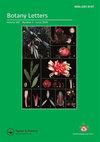Insights into palaeobotany
IF 1.3
4区 生物学
Q3 PLANT SCIENCES
引用次数: 0
Abstract
Palaeobotany is the science devoted to the study of fossil plants and their evolution. Prior to the 17 century, fossils were collected as curiosities and seen as freaks of nature (lusus naturae), but during the 18 century natural historians gradually began to understand them as the remains of formerly living organisms (Andrews 1980). The foundation of the scientific discipline was established in the early 19th century by the Frenchman Adolphe Brongniart (1801–1876), the Czech Kaspar Maria von Sternberg (1761–1837), and the German Ernst Friedrich von Schlotheim (1764– 1832), who are considered to be the “fathers” of modern Palaeobotany. They were among the first to apply the binomial system to fossil plants and to write systematic treatise with detailed descriptions and illustrations (Andrews 1980; Torrens 2005). The invention of thin sections and their application to permineralized fossils in 1831 was a major early technical breakthrough (Andrews 1980), enabling microscopy and the description of anatomical features, which greatly improved our knowledge of the relationships and biology of extinct plants. Advances like these led to our understanding of the plants that gave rise to the economically important coals of the Carboniferous Period. It was also soon realised that the geographic distributions of fossil plants conveyed information about Earth history. Fossil plants were central to the formulation of the concept of Gondwana (Suess 1885) and to the recognition of climate change through geological time (Heer 1861). Palynology, on the other hand, is the science devoted to palynomorphs, a general term for entities found in palynological preparations, including pollen and spores, but also cysts or other organisms or parts of organisms. Pollen grains have been described since the 17 century (e.g. Grew 1682). Palaeopalynology was established during the 19 century, with works such as that of Reinsch (1884) who published micrographs of fossil pollen and spores from Russian coal measure. During the 20 century, palaeopalynology became extremely useful for biostratigraphy (i.e. placing rock units in stratigraphic order based on the fossils they contain), not only for the coal industry, but also for petroleum exploration (e.g. Potonie 1934; Schopf 1957). During the first half of the 20 century the fossil record continued to inform on plant evolution through the discovery of key extinct groups that bridged major living clades, notably the pteridosperms (Oliver and Scott 1904), the early land plants of the Rhynie chert (Kidston and Lang 1921), and the progymnosperms (Beck 1960). One landmark synthesis was the ambitious Traité de Paléobotanique, which was edited by Édouard Boureau (1913–1999) and published in four volumes (Boureau 1964–1975). Other innovations included the further development of pollen analysis as a tool for the study of vegetation change during the Quaternary Period (Faegri and Iversen 1950). Today, palaeobotany and palaeopalynology continue to play important roles in developing our understanding of the evolution of plants and floras, climate change, and biostratigraphy. They are developing as interdisciplinary fields. Research areas such as geochemistry, molecular developmental biology, microbiology, biomechanics, and phylogenetics are transforming our approaches to, and perceptions of, the analysis of fossil plants and ancient ecosystems (Taylor et al. 2009). Likewise, advances in imaging methods including electron and confocal microscopy and more recently high-resolution X-ray computed tomography are opening new ways of looking at plant fossils. Issue 169 (4) and the first part of issue 170 (2) present a selection of articles showing the dynamism of Palaeobotany today. These contributions are summarized below.对古植物学的见解
古植物学是专门研究植物化石及其进化的科学。在17世纪之前,化石被视为奇珍异宝,被视为大自然的怪胎(lusus natureae),但在18世纪,自然历史学家逐渐开始将它们理解为以前活着的生物的遗骸(Andrews 1980)。科学学科的基础是由法国人阿道夫·布朗尼亚特(1801–1876)、捷克人卡斯帕·玛丽亚·冯·斯滕伯格(1761–1837)和德国人恩斯特·弗里德里希·冯·施洛塞姆(1764–1832)在19世纪初建立的,他们被认为是现代古植物学的“鼻祖”。他们是最早将二项式系统应用于化石植物的人之一,并撰写了带有详细描述和插图的系统论文(Andrews 1980;Torrens 2005)。1831年,薄切片的发明及其在再矿化化石中的应用是早期的一项重大技术突破(Andrews 1980),使显微镜和解剖特征的描述成为可能,这大大提高了我们对灭绝植物的关系和生物学的了解。这样的进步使我们了解了石炭纪产生重要经济煤的植物。人们也很快意识到,化石植物的地理分布传达了有关地球历史的信息。化石植物是冈瓦纳大陆概念形成的核心(Suess 1885)和通过地质时间认识气候变化的核心(Heer 1861)。另一方面,孢粉学是专门研究孢粉形态的科学,这是在孢粉学制剂中发现的实体的总称,包括花粉和孢子,也包括包囊或其他生物或生物的部分。花粉粒的描述始于17世纪(例如Grew 1682)。古孢粉学建立于19世纪,Reinsch(1884)发表了俄罗斯煤系花粉和孢子化石的显微照片。在20世纪,古孢粉学在生物地层学(即根据岩石所含化石按地层顺序排列岩石单元)方面变得非常有用,不仅对煤炭工业,而且对石油勘探也非常有用(例如,Potonie 1934;Schopf 1957)。在20世纪上半叶,化石记录继续为植物进化提供信息,通过发现桥接主要现存分支的关键灭绝类群,特别是蕨类植物(Oliver和Scott 1904)、Rhynie chert的早期陆地植物(Kidston和Lang 1921)和前共生植物(Beck 1960)。一个里程碑式的合成作品是雄心勃勃的Traitéde Paléobotanique,由Édouard Boureau(1913–1999)编辑,分四卷出版(Boureau 1964–1975)。其他创新包括进一步发展花粉分析,将其作为研究第四纪植被变化的工具(Faegri和Iversen,1950年)。今天,古植物学和古孢粉学在发展我们对植物和植物群进化、气候变化和生物地层学的理解方面继续发挥着重要作用。它们正在作为跨学科领域发展。地球化学、分子发育生物学、微生物学、生物力学和系统发育学等研究领域正在改变我们对化石植物和古代生态系统分析的方法和看法(Taylor等人,2009)。同样,包括电子和共焦显微镜在内的成像方法的进步,以及最近的高分辨率X射线计算机断层扫描,为观察植物化石开辟了新的途径。第169期(4)和第170期(2)的第一部分精选了一些文章,展示了当今古植物学的活力。这些贡献概述如下。
本文章由计算机程序翻译,如有差异,请以英文原文为准。
求助全文
约1分钟内获得全文
求助全文
来源期刊

Botany Letters
Agricultural and Biological Sciences-Plant Science
CiteScore
3.10
自引率
6.70%
发文量
54
期刊介绍:
Botany Letters is an international scientific journal, published by the French Botanical Society (Société botanique de France) in partnership with Taylor & Francis. Botany Letters replaces Acta Botanica Gallica, which was created in 1993, building on over a century of renowned publications by the Société botanique de France.
 求助内容:
求助内容: 应助结果提醒方式:
应助结果提醒方式:


